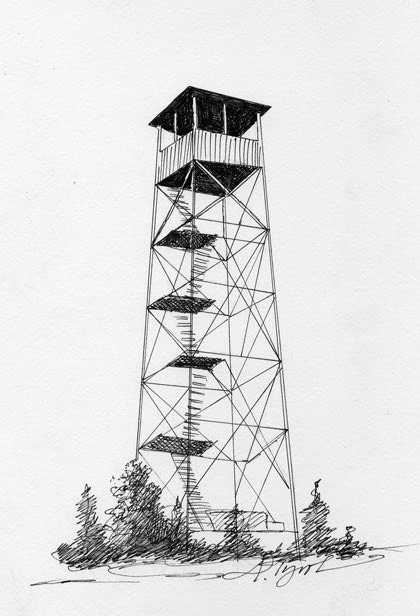
Some of the best views in Vermont and New Hampshire are found at the top of fire towers. But with most of the states’ towers long since taken down, and with those few still remaining now used primarily for recreation, the question comes up: what happened to all the fires that these towers were built to detect?
The first part of the answer is that, back in the early decades of the twentieth century when most of the twin states’ towers were built, there really were more fires than there are now. The construction of lookout towers in New England followed a spate of forest fires between 1888 and 1903 that burned tens of thousands of acres, especially in the White Mountains. Logging practices of the time were the chief culprit. Thousands of acres were often clearcut in a single year, leaving the resulting slash (limbs and tops) out in the open, where they dried in the summer sun. All they needed was a lightning strike.
Especially in the White Mountains, where wood-fired railroads were the chief means of transporting timber from landing to mill, the railroad engines themselves would often shoot off sparks and ignite slash left alongside the track. The passenger trains that crisscrossed Vermont and New Hampshire were also fired by either wood or coal, providing yet another ready source of ignition for the dry woods of a typical dry spring or late summer.
At one time, New Hampshire had 91 fire towers. The first publicly funded tower in the state was built on the north summit of Kearsarge Mountain in 1903, although some accounts claim that Croydon Peak’s fire tower may have been even earlier. Vermont had 35 towers on its peaks at one point, the first of which was built with private funds on Burke Mountain in 1913. The Vermont state forester felt strongly enough about fire protection to champion a law that took effect in 1910 under which the state built towers – and staffed them – on private land at public expense.
The second reason for the proliferation of fire towers in the early twentieth century was the U.S. Forest Service’s “no burn” policy. The Forest Service, whose early land holdings and exposure to forest fires were all in the West, declared zero tolerance for forest fires on their lands all across the country in order to prevent large wildfires. The policy made little ecological sense in the West, where most National Forests are dependent on fire for long-term health , and even less so in the East, where the wet forests are not naturally prone to large-scale conflagrations unless they have been heavily logged.
But fire towers were built in the Northeast nevertheless. Most towers in both states were built by the Civilian Conservation Corps during the 1930s, nearly three decades after the worst logging-induced fires had passed. Nationwide, over 8,000 were in use during the peak decade of the 1930s.
In the early twentieth century, fire towers on mountain tops were the only way for fire wardens to efficiently observe large areas of forest. Once airplanes became relatively common and inexpensive to operate, land managers turned to aircraft for forest fire monitoring. Whereas fire towers had to be maintained, and, in places, staffed year round, airplanes are only required when the fire danger is high. Fire towers began to be closed down throughout the U.S. in the 1960s, once the airplane became the preferred method of fire detection and suppression.
Another reason for the end of the fire tower era is the relatively recent shift in land management across the U.S. towards letting smaller, naturally caused fires burn more frequently. Ecosystem diversity and forest health depend on natural fire regimes, especially in the West. Smaller, more frequent fires lessen the amount of brush on the forest floor and decrease the possibility that catastrophic fires (of the type that fire towers were originally built to prevent) will occur in the first place.
Today, 31 fire towers remain in New Hampshire and 12 in Vermont. Most towers were removed in the 1960s and 1970s, when their advancing age and lack of maintenance made them hazardous. Though most fire towers had steel frames, the stair treads and floors were made of wood, which did not last long in the harsher climate of mountain peaks.
Of the 42 fire towers that do remain, most have now been converted into a new use unforeseen by their original builders: as observation platforms used by passing hikers. The towers provide a view both of the forests below and of a time in our nation’s history when attitudes towards land management, forestry, and fire control were much different than they are today.

